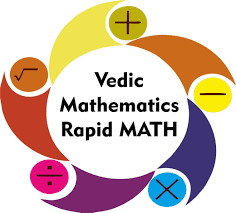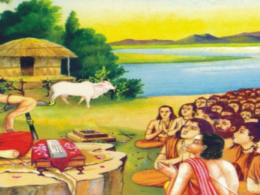“Does Your Child Struggle with Math? Do They Dislike Solving Problems and Working with Numbers?”
“As parents, we often worry about our child’s progress in school, especially in subjects like Math. Fortunately, there are many ways to support their overall growth, especially in Mathematics. One such option is Vedic Maths, a method that originated in India.”

“Vedic Maths is a speedy mental math method rooted in ancient Indian knowledge called Vedas. It’s handy for basic operations like adding, subtracting, multiplying, and dividing, as well as tackling advanced math like Algebra and Trigonometry. With 16 easy-to-learn formulas, such as Vertically and Crosswise, it simplifies complex problems. Practice these, and Vedic Maths makes math easier and more convenient.”
“Practicing Vedic Math helps kids tackle tricky math questions, encouraging mental calculation. It boosts mental abilities, creativity, sharp thinking, and intelligence, making them feel more sure of themselves.”
Article: “The Importance of Learning Abacus for Your Child Explained”
“Learning Vedic Maths helps your child become less reliant on calculators and gives them handy ways to double-check their work. Let’s dive into the perks of Vedic Maths classes for your kid!”
1.Efficient Calculations: Vedic Maths introduces kids to quick and efficient calculation methods. Techniques like “Vertically and Crosswise” make addition, subtraction, multiplication, and division faster, reducing the time and effort required for solving math problems.
Efficient calculations in Vedic Maths involve the application of specific techniques to perform arithmetic operations quickly and with less effort. Here’s a detailed explanation of how Vedic Maths promotes efficient calculations.
- Vertically and Crosswise(Nikhilam Sutra):
Method: This technique is used for Multiplication.
Explanation: Numbers are multiplied by breaking them down into components and multiplying them vertically and crosswise. It simplifies the multiplication process, especially for large.
1.All from Nine and the Last from Ten (Anurupyena Sutra):
Method: This technique is used for subtraction.
Explanation: Subtracting numbers is simplified by complementing digits to 9 and 10. It reduces the complexity of borrowing and makes subtraction quicker.
2.By One More than the One Before (Ekadhikena Purvena Sutra):
Method: This technique is used for multiplication.
Explanation: Multiplying a number by the next consecutive number is made easier by using the base of the previous number. It simplifies multiplication by avoiding the need for multiplication tables.
3.Vertically and Crosswise on the Flag (Yavadunam Tavadunikritya Vargancha Yojayet):
Method: This technique is used for squaring numbers.
Explanation: Squaring involves breaking down numbers into components and performing multiplication using a crosswise method. It speeds up the squaring process for both two-digit and three-digit numbers.
4.Sub-Sutra (Urdhva-Tiryagbhyam):
Method: This technique is used for general multiplication.
Explanation: The sub-sutra involves a combination of vertical and crosswise multiplication. It simplifies multiplication by breaking down numbers into smaller components and multiplying them in a systematic manner.
5.Base Method (Sesanyankena Charamena):
Method: This technique is used for multiplication.
Explanation: It involves using bases and complements to simplify multiplication. The method reduces the number of steps and makes multiplication more efficient, especially for large numbers.
Vedic Maths techniques are designed to simplify calculations by providing alternative methods that often require fewer steps than traditional approaches. These methods not only enhance speed but also contribute to a deeper understanding of the underlying mathematical concepts.
2.Enhanced Problem-Solving Skills:
Enhanced problem-solving skills through Vedic Maths involve the application of versatile techniques that encourage creative thinking and flexibility in approaching mathematical challenges. Here’s a detailed explanation of how Vedic Maths promotes enhanced problem-solving skills:
1.Multiple Approaches to Multiplication:
Method: Vedic Maths offers various techniques for multiplication, such as Vertically and Crosswise, By One More than the One Before, and Sub-Sutra.
Explanation: By learning multiple methods, children gain the ability to choose the most efficient approach based on the numbers involved. This versatility fosters adaptability in problem-solving.
2.Adaptable Subtraction Techniques:
Method: Techniques like All from Nine and the Last from Ten provide alternative ways of subtracting numbers.
Explanation: Children learn to apply different subtraction methods based on the numbers involved. This flexibility promotes adaptive thinking and a deeper understanding of the relationships between numbers.
3.Squaring Techniques for Various Digits:
Method: Vedic Maths offers specific methods for squaring two-digit and three-digit numbers.
Explanation: Understanding different techniques for squaring numbers allows children to choose the most suitable method for a given problem. This adaptability contributes to their problem-solving repertoire.
4.Creative Thinking in Division:
Method: Vedic Maths introduces creative approaches to division, making it more intuitive.
Explanation: By exploring alternative methods for division, children develop creative thinking skills. They learn to approach division problems in ways that align with their understanding of numbers.
5.Application in Complex Mathematics:
Method: The 16 sutras (formulas) in Vedic Maths, including specific methods like Criss-Cross, provide tools for tackling advanced mathematics.
Explanation: By mastering these sutras, children gain problem-solving skills that extend to complex areas like Algebra, Calculus, and Trigonometry. This prepares them for more advanced mathematical challenges.
6.Real-Life Problem Applications:
Method: Vedic Maths emphasizes practical applications of mathematical concepts.
Explanation: Through real-life examples and scenarios, children learn to apply Vedic Maths techniques to solve everyday problems. This connection to real-world situations enhances their problem-solving abilities in various contexts.
7. Encouragement of Experimentation:
Method: Vedic Maths encourages experimenting with different methods.
Explanation: Children are motivated to explore various approaches to problem-solving. This experimentation fosters a sense of curiosity and innovation, contributing to their overall problem-solving capabilities.
In essence, enhanced problem-solving skills in Vedic Maths stem from the exposure to multiple methods, adaptability in choosing techniques, and the application of these skills to both basic and complex mathematical scenarios. This approach not only strengthens mathematical abilities but also nurtures a creative and flexible mindset in children.
3.Improved Mental Math: Improved mental math through Vedic Maths involves honing the ability to perform mathematical calculations mentally, without relying heavily on external aids like paper or calculators. Here’s a detailed explanation of how Vedic Maths contributes to improved mental math skills:
1.Speedy Addition:
Method: Techniques like “Vertically and Crosswise” enable quick addition.
Explanation: Vedic Maths encourages breaking down numbers into components and mentally adding them, reducing the need for writing down each step. This enhances the speed and efficiency of mental addition.
2.Efficient Subtraction:
Method: Techniques like “All from Nine and the Last from Ten” simplify mental subtraction.
Explanation: By complementing digits to 9 and 10, mental subtraction becomes more intuitive. This reduces the need for borrowing and promotes faster mental calculations.
3. Versatile Multiplication:
Method: Vedic Maths provides multiple methods like “By One More than the One Before” and “Sub-Sutra” for mental multiplication.
Explanation: Learning various multiplication techniques enables children to choose the most suitable method for mental calculations, enhancing their overall mental math proficiency.
4. Quick Squaring Techniques:
Method: Vedic Maths offers specific methods for mentally squaring numbers.
Explanation: Techniques like “Vertically and Crosswise on the Flag” simplify squaring, allowing children to mentally square two-digit and three-digit numbers more efficiently.
5. Flexible Division Approaches:
Method: Vedic Maths introduces creative approaches to mental division.
Explanation: By exploring alternative methods for mental division, children develop the ability to perform division calculations mentally with greater speed and accuracy.
6. Daily Practice for Mental Agility:
Method: Regular Vedic Maths practice sessions focus on mental math exercises.
Explanation: Daily practice of mental math techniques sharpens the mind and enhances mental agility. Children gradually become adept at performing calculations in their minds effortlessly.
7. Application of Sutras for Mental Calculations:
Method: The 16 sutras (formulas) in Vedic Maths provide mental math shortcuts.
Explanation: By applying these sutras, children learn to mentally calculate complex mathematical expressions and equations. This not only improves mental math skills but also builds confidence in tackling challenging problems mentally.
8. Real-time Problem-Solving:
Method: Vedic Maths emphasizes solving problems mentally in real-time.
Explanation: Through practical exercises and timed challenges, children learn to think on their feet and solve problems quickly, enhancing their mental math abilities in various scenarios.
In summary, improved mental math skills in Vedic Maths are cultivated through a combination of versatile techniques, regular practice, and the application of sutras. The focus on mental calculations not only accelerates the learning process but also instills a sense of confidence and independence in children’s mathematical abilities.
4. Boosted Confidence:
Boosted confidence is a significant outcome of learning Vedic Maths, as it empowers children to tackle mathematical challenges with assurance. Here’s a detailed explanation of how Vedic Maths contributes to boosted confidence:
1.Success in Quick Calculations:
Explanation: Vedic Maths equips children with techniques like “Vertically and Crosswise” and “All from Nine,” enabling them to perform calculations quickly. Successfully mastering these methods boosts their confidence in handling math problems efficiently.
2. Mental Math Proficiency:
Explanation: Vedic Maths emphasizes mental math, and as children become adept at mentally calculating, they gain confidence in their ability to perform calculations without the need for external aids like calculators or written notes.
3. Versatility in Problem-Solving:
Explanation: Learning multiple approaches to problem-solving in Vedic Maths gives children a toolkit of methods. This versatility instills confidence, as they can choose the most effective approach based on the nature of the problem.
4. Positive Learning Experience:
Explanation: Vedic Maths offers an engaging and interactive learning experience. Success in applying these methods creates a positive association with mathematics, fostering confidence in approaching mathematical challenges.
5. Independence in Learning:
Explanation: The self-reliance that comes with mastering Vedic Maths techniques encourages independence in learning. Children gain confidence in their ability to understand and solve mathematical problems on their own.
6. Visible Progress and Achievements:
Explanation: Regular practice and application of Vedic Maths yield visible progress. As children witness their improvement in quick calculations and mental math, they feel a sense of achievement, enhancing their overall confidence.
7. Effective Problem-Solving in Real-Life Situations:
Explanation: Vedic Maths emphasizes practical applications. When children successfully use these techniques to solve real-life problems, they gain confidence in their ability to apply mathematical concepts to everyday situations.
8. Positive Feedback and Encouragement:
Explanation: Positive feedback from teachers, parents, or peers reinforces a child’s confidence. Recognition of their efforts and achievements in mastering Vedic Maths techniques contributes to a positive self-perception in relation to mathematics.
9. Preparation for Advanced Mathematics:
Explanation: Vedic Maths lays a strong foundation for advanced mathematical concepts. Knowing that they are equipped with these foundational skills boosts a child’s confidence when approaching more complex areas of mathematics.
10. Cultivation of a Growth Mindset:
Explanation: The process of learning Vedic Maths encourages a growth mindset, where challenges are viewed as opportunities to learn and improve. This mindset shift fosters resilience and confidence in the face of mathematical challenges.
In summary, boosted confidence in Vedic Maths is a result of successful and efficient problem-solving, mental math proficiency, positive learning experiences, visible progress, and the development of a growth mindset. This confidence extends beyond mathematics, positively impacting a child’s overall approach to learning and problem-solving in various areas of life.
5. Accelerated Learning:
Accelerated learning in the context of Vedic Maths involves a quicker and more efficient grasp of mathematical concepts and operations. Here’s a detailed explanation of how Vedic Maths contributes to accelerated learning:
1.Simplified Techniques:
Explanation: Vedic Maths provides simplified and alternative techniques for basic arithmetic operations such as addition, subtraction, multiplication, and division. These methods reduce the number of steps involved, enabling children to learn and apply them more quickly.
2.Focus on Mental Math:
Explanation: Vedic Maths places a strong emphasis on mental calculations. By training children to perform calculations mentally, they develop a faster and more intuitive understanding of numbers, leading to accelerated learning.
3.Versatile Approaches:
Explanation: Learning multiple approaches to solving mathematical problems in Vedic Maths allows children to choose the method that suits them best. This versatility accelerates the learning process by providing various entry points to understanding mathematical concepts.
4.Practical Application of Sutras:
Explanation: The 16 sutras (formulas) in Vedic Maths are designed for practical application. Children can quickly apply these sutras to solve a wide range of mathematical problems, fostering accelerated learning through hands-on experience.
5.Daily Practice Routine:
Explanation: Vedic Maths encourages regular and consistent practice. Daily practice sessions, focused on specific techniques and sutras, contribute to the reinforcement of concepts and the acceleration of learning.
6.Real-Life Problem Solving:
Explanation: Vedic Maths incorporates real-life problem-solving scenarios. Applying mathematical concepts to practical situations accelerates learning by making the subject more relatable and applicable to everyday life.
7.Efficient Learning of Advanced Concepts:
Explanation: Vedic Maths not only covers basic arithmetic but also lays the groundwork for advanced mathematical concepts. Children can quickly grasp and apply these foundational skills when introduced to more complex areas of mathematics.
8.Positive Learning Environment:
Explanation: Vedic Maths classes often create a positive and engaging learning environment. A positive atmosphere, combined with the use of interactive techniques, contributes to an accelerated learning experience.
9.Application in School Curriculum:
Explanation: Integrating Vedic Maths concepts with the regular school curriculum allows children to apply their accelerated learning directly to their academic studies, reinforcing their understanding of mathematical principles.
10.Continuous Skill Development:
Explanation: Vedic Maths encourages continuous skill development. As children progress through different levels of difficulty, they build on their existing knowledge, leading to a steady and accelerated growth in mathematical proficiency.
In summary, accelerated learning in Vedic Maths is facilitated by simplified techniques, a focus on mental math, versatile approaches, practical application of sutras, consistent practice routines, real-life problem-solving, efficient learning of advanced concepts, a positive learning environment, integration with the school curriculum, and continuous skill development. This holistic approach contributes to a faster and more effective acquisition of mathematical skills.
6. Creative Thinking:
Vedic Mathematics, an ancient Indian system of mathematical techniques derived from Vedas, can also contribute to creative thinking. While Vedic Maths is known for its efficiency in calculations, its underlying principles and methods can stimulate creative thinking in several ways:
1.Alternative Approaches to Problem Solving: Vedic Mathematics offers alternative methods for solving mathematical problems. Encouraging students to explore and use different approaches fosters creative thinking by breaking away from conventional problem-solving techniques.
2.Pattern Recognition: Vedic Maths often involves recognizing patterns and relationships between numbers. This develops a sense of pattern recognition, a cognitive skill that is crucial for creative thinking across various disciplines.
3.Flexibility in Calculation Methods: Vedic Maths provides multiple ways to perform calculations. This flexibility encourages students to think creatively about which method is most suitable for a particular problem, promoting adaptability and creativity in mathematical thinking.
4.Visualization Techniques: Some Vedic Maths techniques involve visualization, such as the “Nikhilam Sutra” for multiplication. Encouraging students to visualize mathematical operations fosters creativity by engaging the imagination and helping them understand abstract concepts in a concrete way.
5.Combining Mathematical Concepts: Vedic Maths often involves the combination of different mathematical concepts within a single technique. This interdisciplinary approach encourages creative thinking by showing students how different mathematical ideas can work together synergistically.
6.Efficiency and Innovation: Vedic Maths emphasizes efficiency in calculations. This efficiency can inspire creative thinking by challenging students to find innovative ways to simplify and optimize processes, leading to more elegant and streamlined solutions.
7.Mindfulness and Concentration: Vedic Maths places a strong emphasis on mental calculations. Developing mental clarity, mindfulness, and concentration through these techniques can enhance creative thinking by improving overall cognitive abilities and focus.
8.Application to Real-Life Scenarios: Vedic Maths techniques can be applied to real-life scenarios, encouraging students to think creatively about how mathematical concepts are relevant in everyday situations. This practical application helps bridge the gap between theoretical knowledge and creative problem-solving skills.
While Vedic Mathematics primarily focuses on efficient computation, its holistic approach can contribute to the development of creative thinking skills in students. Integrating these methods with broader educational strategies that promote creativity can provide a well-rounded approach to mathematical learning.










